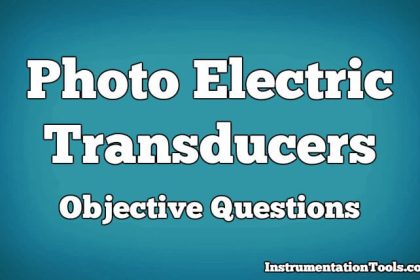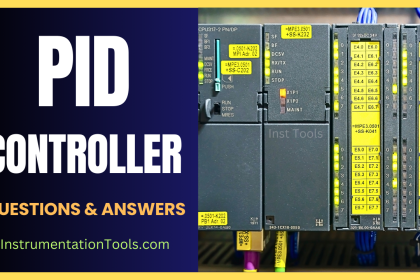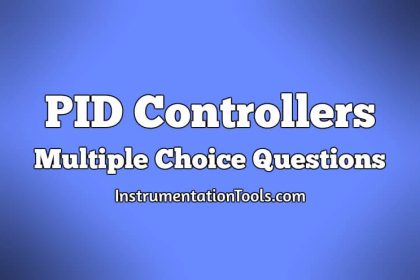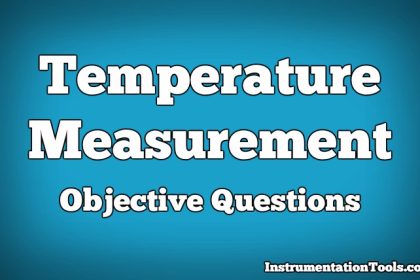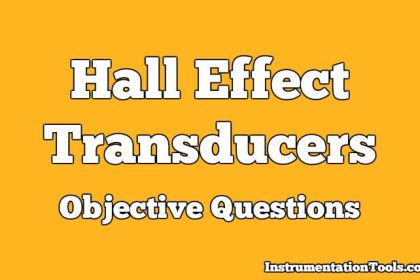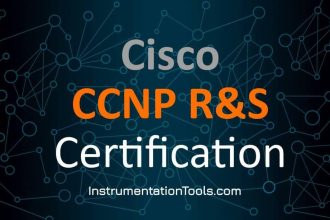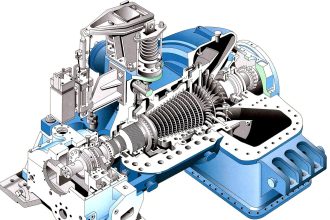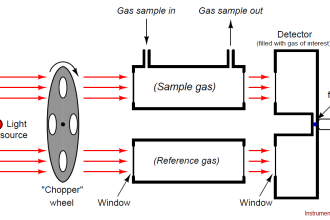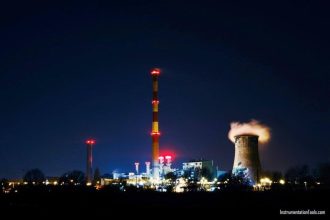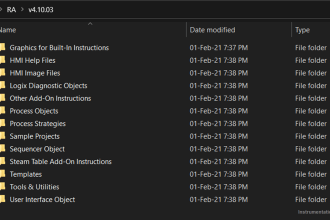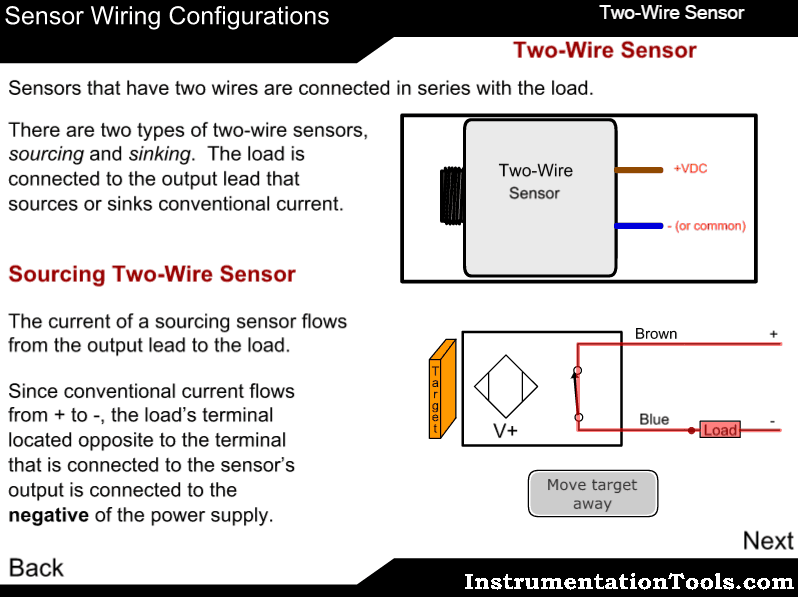In this article, you will find the fiber optics objective questions and answers for instrumentation, electrical, and electronics engineers.
Fiber Optics Objective Questions and Answers
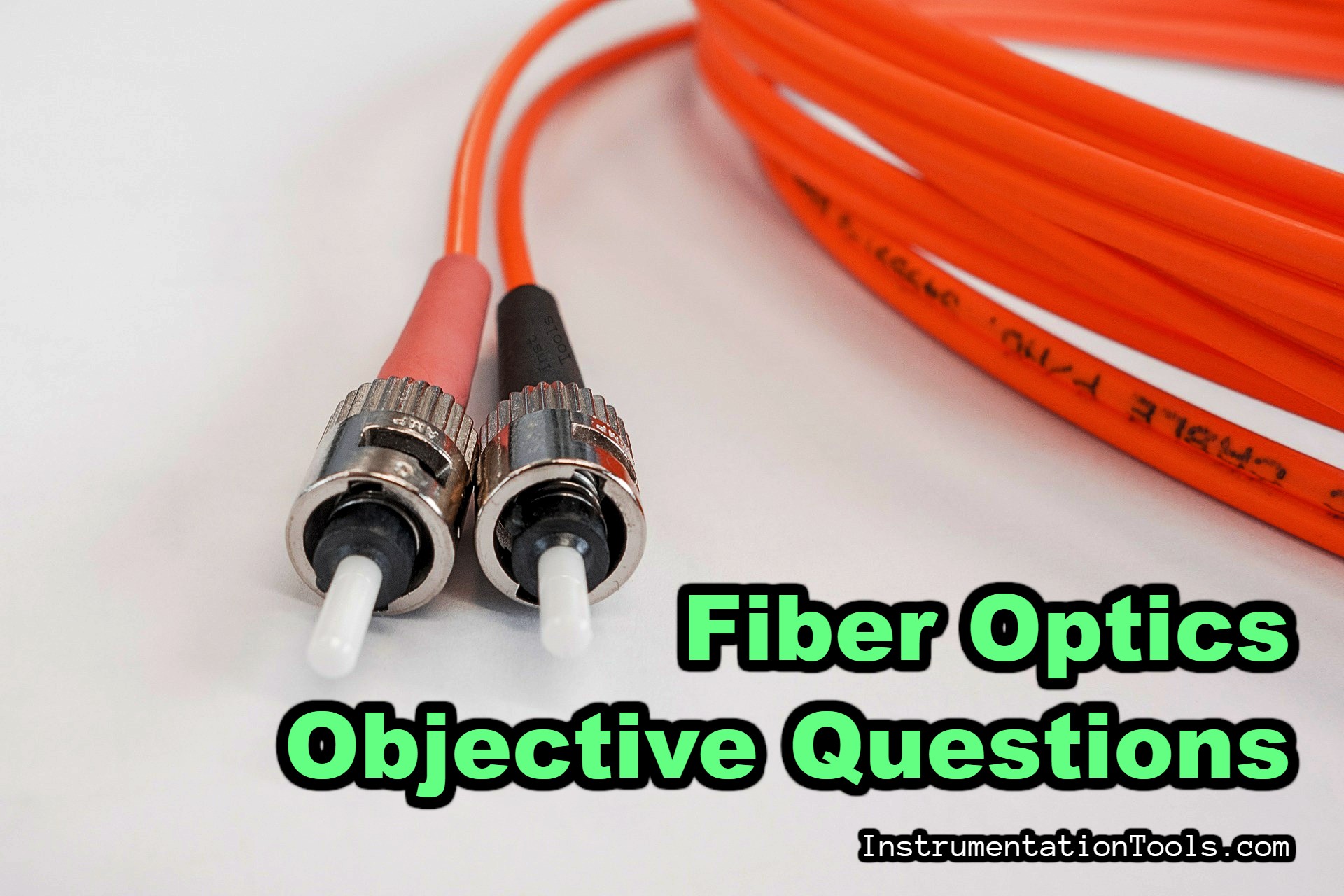
The below list provides all the multiple-choice questions (MCQ) related to the optical fiber.
Answers are available at the bottom of the article.
1. What does an opaque substance do when light rays fall on it?
| A) | Transmits and diffuses them |
| B) | Reflects or absorbs them |
| C) | Transmits them only |
| D) | Refracts them |
2. The loss of optical power as light travels along a fiber is called
| A) | dispersion |
| B) | scattering |
| C) | attenuation |
| D) | absorption |
3. When light falls on a piece of black paper, what happens to most of the light?
| A) | It is refracted |
| B) | It is scattered |
| C) | It is absorbed |
| D) | It is reflected |
4. Light exhibits what kind of wave motion?
| A) | Transverse |
| B) | Turbulent |
| C) | Longitudinal |
| D) | Aperiodic |
5. A radius of curvature is larger than the fiber diameter in which of the following types of fiber bends?
| A) | Macrobends |
| B) | Microbends |
| C) | Serpentine bends |
| D) | Gentle bends |
6. What are the two parts of a fiber optic receiver?
| A) | Fiber and optical detector |
| B) | Fiber and case |
| C) | Optical detector and signal conditioning circuits |
| D) | Optical detector and PIN diode |
7. What multimode fiber properties help reduce connection losses?
| A) | Smaller core size and higher NA |
| B) | Larger core size and lower NA |
| C) | Larger core size and higher NA |
| D) | Smaller core size and lower NA |
8. Extremely high losses occurred in early fibers because of which of the following conditions?
| A) | Holes in the fiber sides |
| B) | Core areas too small in the fibers |
| C) | Cracks in the fibers |
| D) | Impurities in the fiber material |
9. What are the two types of optical detectors?
| A) | LEDs and APDs |
| B) | APDs and laser diodes |
| C) | PIN diodes and APDs |
| D) | Laser diodes and PIN diodes |
10. Which of the following factors is a description of transverse wave motion?
| A) | The wave magnitude varies perpendicular to the direction of wave motion |
| B) | The wave motion is not predictable |
| C) | any of these answers |
| D) | The wave magnitude varies parallel to the direction of propagation |
11. The cladding performs all except which of the following functions?
| A) | Reduces the scattering loss at the surface of the core |
| B) | Reduces the loss of light from the core |
| C) | Reduces mechanical strength |
| D) | Protects the fiber core from absorbing surface contaminants |
12. Besides the transmitter, the optical fiber, and the receiver, which of the following components may be found in a fiber optic link?
| A) | Splices, couplers, and connectors |
| B) | Splices only |
| C) | Connectors only |
| D) | Couplers only |
13. A light wave passes from one medium into another medium with a different velocity.
As the wave enters the second medium, the change of direction is known by which of the following terms?
| A) | Absorption |
| B) | Refraction |
| C) | Diffusion |
| D) | Reflection |
14. Total internal reflection occurs at which of the following angles?
| A) | Fresnel angle |
| B) | Obtuse angle |
| C) | Critical angle of incidence |
| D) | Right angle |
15. Attenuation is specified in what units?
| A) | μm |
| B) | dB |
| C) | dB/km |
| D) | μm/km |
16. Compared to a low-order mode, the electrical and magnetic fields of a high-order mode are distributed more toward the center of a fiber.
| A) | False |
| B) | True |
17. Compared to multimode fibers, single-mode fibers have a larger core size.
| A) | False |
| B) | True |
18. Which of the following substances is a good example of a translucent substance?
| A) | Cardboard |
| B) | Aluminum foil |
| C) | Clear glass |
| D) | Frosted glass |
19. Increased extrinsic absorption at 950 nm, 1,250 nm, and 1,383 nm is caused by what impurity in glass optical fibers?
| A) | Titanium |
| B) | Germanium |
| C) | Phosphorus |
| D) | Water |
20. The lowest signal loss and the highest bandwidth are characteristic of which of the following types of fibers?
| A) | Air core |
| B) | Multimode |
| C) | Single mode |
| D) | Plastic core |
21. Fiber optics uses what medium to send information?
| A) | Photons |
| B) | Light |
| C) | Electrons |
| D) | Link 11 |
22. To describe the nature of light, which of the following ways can be used?
| A) | Particles of energy only |
| B) | Electromagnetic waves and particles of energy |
| C) | Electromagnetic wave only |
| D) | Element |
23. When different colors of light travel through the fiber at different speeds, which of the following types of dispersion occurs?
| A) | Intermodal |
| B) | Intramodal (chromatic) |
| C) | Modal |
| D) | Atmospheric |
24. What are the three parts of a fiber optic data link?
| A) | Optical fiber, optical connectors, optical splices |
| B) | Transmitter, optical fiber, optical connectors |
| C) | Optical fiber, optical connectors, receiver |
| D) | Transmitter, optical fiber, receiver |
25. Only in multimode fibers does which of the following types of dispersion occur?
| A) | Waveguide |
| B) | Material |
| C) | Chromatic |
| D) | Modal |
26. A light wave is incident on a surface.
The reflected power is the greatest in which of the following incidences?
| A) | 45º |
| B) | 30º |
| C) | Perpendicular |
| D) | Almost parallel |
27. Of the following factors, which ones are the advantages of fiber optic systems?
| A) | Electrical isolation and immunity to noise |
| B) | Immunity to noise and low bandwidth |
| C) | Signal security and high price |
| D) | Electrical isolation and low bandwidth |
28. Which type of scattering loss is proportional to the reciprocal of the fourth power of the wavelength of the light?
| A) | Mie |
| B) | Brillouin |
| C) | Rayleigh |
| D) | Raman |
29. The relationship between the incident rays and the refracted rays at a boundary between mediums with different indexes of refraction describes what law?
| A) | Law of Reflection |
| B) | Snell’s Law |
| C) | Murphy’s Law |
| D) | Bragg’s Law |
30. What is the definition of a bound ray?
| A) | A ray that propagates through the fiber by total internal reflection |
| B) | A ray that travels in the air |
| C) | A ray that cannot move |
| D) | A ray that is refracted out of the fiber |
31. Which of the following substances is an example of an opaque substance?
| A) | Clear glass |
| B) | Frosted glass |
| C) | Cardboard |
| D) | Oiled paper |
32. What is the name of the law that states “The angle of incidence is equal to the angle of reflection”?
| A) | Snell’s Law |
| B) | Law of Entropy |
| C) | Law of Reflection |
| D) | Murphy’s Law |
33. Which of the following objects is NOT an example of a luminous source?
| A) | Flashlight |
| B) | Mirror |
| C) | Gas flame |
| D) | Sun |
34. System performance is affected most by which of the following fiber properties?
| A) | Core diameter and cladding |
| B) | Attenuation and dispersion |
| C) | Core diameter and NA |
| D) | NA and delta |
35. The fiber optic transmitter has which of the following functions?
| A) | Converts the electrical input signal to an optical signal |
| B) | Amplifies the output electrical signal |
| C) | Amplifies the optical signal |
| D) | Converts the input optical signal to an electrical signal |
36. What are the three basic parts of an optical fiber?
| A) | Core, cladding, and coating |
| B) | Hole, shell, and coating |
| C) | Inside, middle, and outside |
| D) | Fiber, kevlar, and jacket |
37. What is another word for diffused?
| A) | Absorbed |
| B) | Refracted |
| C) | Scattered |
| D) | Attenuated |
38. High-order modes cross the axis of the fiber at steeper angles than low-order modes.
| A) | True |
| B) | False |
39. Compared to single-mode fibers, multimode fibers have which of the following advantages?
| A) | Ease of launching light into them only |
| B) | Ease of both making connections and launching light into them |
| C) | Ease of making connections only |
| D) | Lower dispersion |
40. What fiber mechanisms weaken and distort the optical signal launched into the fiber?
| A) | Scattering, absorption, and dispersion |
| B) | Scattering, reflection, and refraction |
| C) | Scattering, radiation, and absorption |
| D) | Dispersion, radiation, and absorption |
41. Glass optical fibers have low loss between the infrared and ultra-violet absorptive regions.
The approximate wavelength of operation for glass optical fibers is in which of the following ranges?
| A) | 1 nm to 700 nm |
| B) | 9 μm to 20 μm |
| C) | 1600 nm to 9000 nm |
| D) | 700 nm to 1600 nm |
42. Which of the following substances is a good example of a transparent substance?
| A) | Frosted glass |
| B) | Clear glass |
| C) | Aluminum foil |
| D) | Cardboard |
43. Fiber optics are being used in which of the following types of applications?
| A) | All of these answers |
| B) | Long-haul communications |
| C) | Subscriber-loop applications |
| D) | Military applications |
44. Electromagnetic wave behavior is used to describe the propagation of light along with the fiber in what theory?
| A) | Mode theory |
| B) | Rayleigh’s theory |
| C) | Particle theory |
| D) | Darwin’s theory |
45. Fiber-optic systems use what two types of optical sources?
| A) | Laser diodes and APDs |
| B) | LEDs and APDs |
| C) | LEDs and laser diodes |
| D) | PIN diodes and LEDs |
46. What does a translucent substance do to light rays that fall on it?
| A) | Transmits and reflects them |
| B) | Transmits and diffuses them |
| C) | Refracts and absorbs them |
| D) | Reflects and absorbs them |
47. The fiber NA relates to which of the following characteristics?
| A) | Speed of light within the fiber |
| B) | Maximum angle within the fiber acceptance cone |
| C) | Tensile strength of the fiber |
| D) | The physical size of the fiber |
48. Of the following advantages, which one does NOT apply to fiber optics?
| A) | Improved environmental |
| B) | Improved signal security |
| C) | Established standards |
| D) | Increased bandwidth |
49. What are the two basic types of fibers?
| A) | Small and large |
| B) | Opaque and diffuse |
| C) | Glass and plastic |
| D) | Single-mode and multimode |
50. Compared to multimode fibers, single-mode fibers tend to have a lower loss and produce less signal distortion.
| A) | True |
| B) | False |
51. How does the speed of light in the fiber compare to the speed of light in the air?
| A) | It is slower in the fiber |
| B) | none of these answers |
| C) | It is the same in both the fiber and the air |
| D) | It is faster in the fiber |
52. Noise has what effect, if any, on the quality of a signal?
| A) | any of these answers |
| B) | Increases |
| C) | None of these answers |
| D) | Reduces |
53. Light is transmitted along with an optical fiber by what two methods?
| A) | Ray theory and photon theory |
| B) | Mode theory and photon theory |
| C) | Ray theory and mode theory |
| D) | Ray theory and quantum theory |
54. The optical source performs which of the following functions?
| A) | Amplifies the optical signal |
| B) | Amplifies the electrical signal |
| C) | Launches the optical signal into the fiber |
| D) | Converts the optical signal to an electrical signal |
55. A skew ray is which of the following types of rays?
| A) | An unbalanced ray |
| B) | A meridional ray |
| C) | A ray that propagates without passing through the center axis of the fiber |
| D) | An unbound ray |
56. The fiber optic receiver performs which of the following functions?
| A) | Converts the optical signal back into an electrical signal |
| B) | Amplifies the electrical signal |
| C) | Amplifies the optical signal |
| D) | Converts the electrical signal back into an optical signal |
57. If a light wave passes from a less dense medium to a more dense medium, how does the angle of refraction compare to the angle of incidence?
| A) | Greater than or equal to the angle of incidence |
| B) | Less than the angle of incidence |
| C) | Greater than the angle of incidence only |
| D) | Equal to the angle of incidence only |
58. What was the first light source developed that could be easily coupled into a fiber?
| A) | Lamp |
| B) | PIN diode |
| C) | LED |
| D) | YAG laser |
59. What does a transparent substance do to light rays that fall on it?
| A) | Refracts them |
| B) | Transmits them |
| C) | Absorbs them |
| D) | Reflects them |
60. What are light waves called that strike a surface but are neither transmitted nor absorbed?
| A) | Diffracted |
| B) | Diffused |
| C) | Reflected |
| D) | Refracted |
Click Here for Answers
If you liked this article, then please subscribe to our YouTube Channel for Electrical, Electronics, Instrumentation, PLC, and SCADA video tutorials.
You can also follow us on Facebook and Twitter to receive daily updates.
Next Quiz:
- Electricity Objective Questions
- Engineering Materials Questions
- Pressure Instrumentation MCQ
- GATE Instrumentation Questions
- Electrical Circuit Measurement
